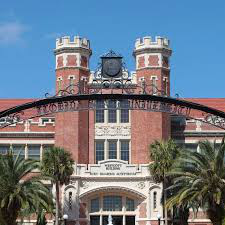Speaker
Description
We report on our recent leading order pionless effective field theory (LO pionless EFT) studies [1,2,3,4,5] of light single- and double-Lambda hypernuclei. These systems are within the focus of current experimental interest since their spectra provide strong constraints in a study of the 2- and 3-body interaction between $\Lambda$ hyperons and nucleons. Application of LO pionless EFT, fitted to available low-energy data, reveals excited state of hypertriton ${\rm ^3_\Lambda H^*}~(J^\pi=3/2^+)$ in a form of a virtual state and predicts possible broad $\Lambda nn~(J^\pi =1/2^+)$ resonance [2,3] with the resonance energy strongly dependent on the size of $\Lambda N$ scattering length. Considering $\Lambda N$ charge symmetry breaking (CSB) and partially conserved baryon-baryon SU(3) flavor symmetry we deduce from the experimental CSB in $\rm ^4_\Lambda H− ^4_\Lambda He$ hypernuclei in-medium $\Lambda$ isospin $I=1$ admixture amplitude [5]. Our result is in agreement with the free-space value ≈1.5% inferred by Dalitz and von Hippel [6] and recent QCD+QED lattice calculations [7]. Extending LO pionless EFT to the double-$\Lambda$ sector we firmly predict bound ${\rm ^5_{\Lambda \Lambda} H~/~^5_{\Lambda \Lambda} He }~(J^\pi = 1/2^+)$ isospin doublet, while four-body ${\rm ^4_{\Lambda \Lambda} H }~(J^\pi =1^+)$ hypernucleus is found on the verge of binding, strongly dependent on the strength of $\Lambda \Lambda$ interaction [1].
References
[1] L. Contessi, M. Schafer, N. Barnea, A. Gal, and J. Mares, Phys. Lett. B 797, 134893 (2019).
[2] M. Schafer, B. Bazak, N. Barnea, and J. Mares, Phys.Lett. B 808 135614 (2020).
[3] M. Schafer, B. Bazak, N. Barnea, and J. Mares, Phys. Rev. C 103, 025204 (2021).
[4] M. Schafer, B. Bazak, N. Barnea, A. Gal, and J. Mares, Phys. Rev. C 105 015202 (2022).
[5] M. Schafer, N. Barnea, and A. Gal, arXiv nucl-th: 2202.07460 (2022).
[6] R. H. Dalitz and F. von Hippel, Phys. Lett 10, 153 (1964).
[7] Z. R. Kordov, R. Horsley, Y. Nakamura et al. Phys. Rev. D 101, 034517 (2020).
| speaker affiliation | The Hebrew University of Jerusalem, Israel |
|---|

